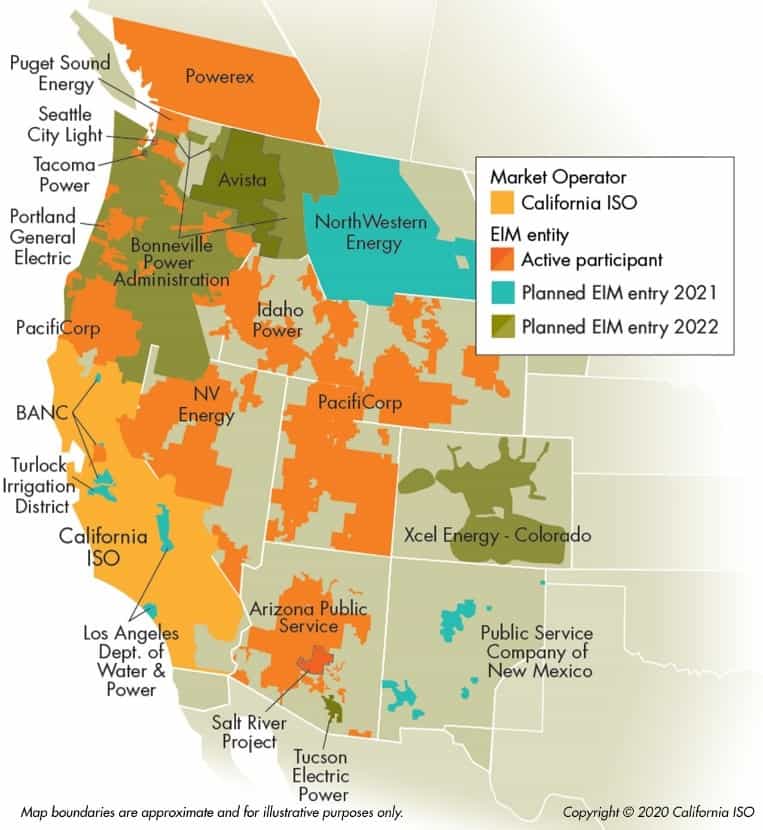
Tracy Rolstad
The EIM has the potential to provide Balancing Authorities in the west with major economic benefits that would otherwise be unavailable to them. Joining the EIM allows Balancing Authorities to leverage generation from each other to achieve their imbalance requirements, which can improve grid reliability and cost savings for participants.
How does EIM work?
The EIM essentially just extends the California ISOs existing real-time market services to be available to more entities outside of its transmission system, allowing other Balancing Authorities in the West to enjoy the benefits of a real-time market. The EIM improves BA’s access to electricity at the time it is generated or needed across the region, reducing congestion, cost, and the need for curtailment of excess generation.

Figure 1 Active and Planned Participants of the EIM, per CAISO
History of the EIM
Participation in the EIM has grown considerably since it began operation in 2014. Today, the market has 11 participants spanning the western U.S. and Canada, with 10 more scheduled to enter in 2021 and 2022. The CAISO estimates that by 2022, the EIM will serve 82 percent of the Western Energy Coordinating Council’s (WECC) total load. [1]
Why join the EIM?
Lower cost access to generation
Balancing Authorities have to meet their own imbalance requirement with their own generation, without access to the cheap generation from other Balancing Authorities. The EIM market solves this problem, greatly reducing the total cost of the imbalance energy dispatch.
Integration of renewables
As participation in the EIM grows, it becomes an enabler for adoption of more renewables across the region. By allowing for the sharing of generation across a geographically diverse area, the EIM mitigates risks associated with weather-related uncertainty inherent to renewable generation. CAISO estimates that market incentives provided by the EIM have led to a reduction in greenhouse gas (GHG) emissions of 533,381 metric tons since 2015.[2]
Because renewable generation is fundamentally more difficult to predict, there is always a difference between forecast generation and actual generation from renewables. The EIM is a 5-minute market, which makes it more reliable for capturing the differences between forecast and reality, which provides for a better dispatch in the EIM market.
Challenges
While the benefits of entry are clear, the practical challenges of preparing for joining the EIM are non-trivial. Balancing Authorities will have to navigate a number of infrastructural and operational hurdles as they prepare to join the EIM.
Infrastructure Challenges
- The Network Model – Balancing Authorities will have to develop an accurate full network model to be represented in the EIM.
- Additional Telemetry – Participants will need additional telemetry at strategic points to allow CAISO’s model to have more observability and redundancy to come up with the state of the entire EIM system at any time. Along with improved telemetry, the wide spread of revenue quality metering is required.
Operational Challenges
- Interchange Scheduling – Balancing Authorities will be challenged to manage the hourly and 5-minute interchange scheduling and communicate it in a timely manner to CAISO to allow for realistic dispatch. Interchange schedules are either created by the BA itself or a third-party that crosses the balancing area. Timely management of the interchange schedules is critical to the operation of the EIM.
- Balancing Schedules – Participants will have to figure out how to balance the base generation schedule and interchange schedule with the load forecast of the Balancing Authority before the real time market at the points required by CAISO. This also means identifying and implementing the infrastructure required to meet this criteria.
- Settlements – Participants will need to understand how to confirm that the charge codes calculated by CAISO meet the requirements of the balancing authority, and how to submit those charges to their sub-participants in the form of statements and invoices.
Balancing Authorities considering entry to the EIM will need to ask themselves critical questions about whether they have the necessary systems and staffing capabilities in place to proceed toward implementation. In the next installment, we will dive into the practical considerations of whether joining the EIM is right for your organization.
Read the next article in this three-part series about the Western EIM.
How PSC Helps
PSC provides clients with strategic consulting and engineering services related to entering the EIM. For more information about how PSC can support your organization with evaluation or entry to the EIM, contact us here or at or send us an email at [email protected].
